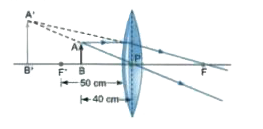An 5 cm tall object is placed on the principal axis of a convex lens of focal length 50 cm at a distance of 40 cm from it. Find the nature, position and size of image.
Here , u = - 40 cm , f= +50 , h = 5 cm , v= ? , h.= ?
Using lens formula ,

Here teh negative sign indicates that the image is formed on the same side of the lens as the object . Therefore, the image is virtual
Now, or
cm
The positive sign of h. shows that the image is erect . Thus in this case, the image is erect, virtual , 25 cm tall , and it is formed at a distance of 200 cm on the same side of lens as the object.
Topper's Solved these Questions
- LIGHT-REFLECTION AND REFRACTIONBOOK - VK GLOBAL PUBLICATIONCHAPTER - LIGHT-REFLECTION AND REFRACTIONEXERCISE - HOTS (HIGHER ORDER THINKING SKILLS)
23 Videos
- LIGHT-REFLECTION AND REFRACTIONBOOK - VK GLOBAL PUBLICATIONCHAPTER - LIGHT-REFLECTION AND REFRACTIONEXERCISE - SOME IMPORTANT NUMERICALS (FOR PRACTICE)
19 Videos
- LIGHT-REFLECTION AND REFRACTIONBOOK - VK GLOBAL PUBLICATIONCHAPTER - LIGHT-REFLECTION AND REFRACTIONEXERCISE - LONG ANSWER QUESTIONS
3 Videos
- ELECTRICITYBOOK - VK GLOBAL PUBLICATIONCHAPTER - ELECTRICITYEXERCISE - SOME IMPORTANT NUMERICALS
12 Videos
- MAGNETIC EFFECTS OF ELECTRIC CURRENTBOOK - VK GLOBAL PUBLICATIONCHAPTER - MAGNETIC EFFECTS OF ELECTRIC CURRENTEXERCISE - HOTS (Higher Order Thinking Skills)
22 Videos
Similar Questions
A 5 cm tall object is placed on the principal axis of convex lens of focal length 50 cm at a distance of 40 cm from it. Find the nature, position and size of the image.
View SolutionAn object 10 cm tall is placed on the principal axis of a concave lens of focal length 10 cm at a distance of 15 cm from it. Find the position and nature of the image formed by the lens and draw the ray diagram.
View SolutionAn object is placed on the principal axis of concave mirror of focal length 10 cm at a distance of 8.0 cm from the pole. Find the position and the nature of the image.
View SolutionAn object 2 cm tall is placed on the axis of a convex lens of focal length 5 cm at a distance of 10 m from the optical center of the lens. Find the nature, position and size of the image formed. Which case of image formation three times. Find the distance of the lens from the filament and the focal length of the lens.
View SolutionA 10 cm tall object is placed perpendicular to the principal axis of a convex lens of focal length 12 cm. The distance of the object from the lens is 18 cm. Find the nature, position and size of the image.
View SolutionA 2.0 cm tall object is placed perpendicular to the principal axis of a convex lens of focal length 10 cm. The distance of the object from the lens is 15 cm. Find the nature, position and size of the image. Also find its magnification.
View SolutionA 2.0cm tall object is placed perpendicular to the principal axis of a convex lens of focal length 10 cm. The distance of the object from the lens is 15 cm. Find the nature, position and size of the image. Also, find its magnification.
View SolutionA 2.0cm tall object is placed perpendicular to the principal axis of a convex lens of focal length 10 cm. The distance of the object from the lens is 15 cm. Find the nature, position and size of the image. Also, find its magnification.
View SolutionOne half of a convex lens of focal length 10 cm is covered with a black paper. Can such a lens produce an image of a complete object placed at a distance of 30 cm from the lens? Draw a ray diagram to justify your answer.
A4 cm tall object is placed perpendicular to the principal axis of a convex lens of focal length 20 cm. The distance of the object from the lens is 15 cm. Find the nature, position and size of the image.
View SolutionA 10 cm tall object is placed perpendicular to the principal axis of a convex lens of focal length 12 cm. The distance of the object from the lens is 18 cm. Find the nature, position and size of the image formed.
View Solution
